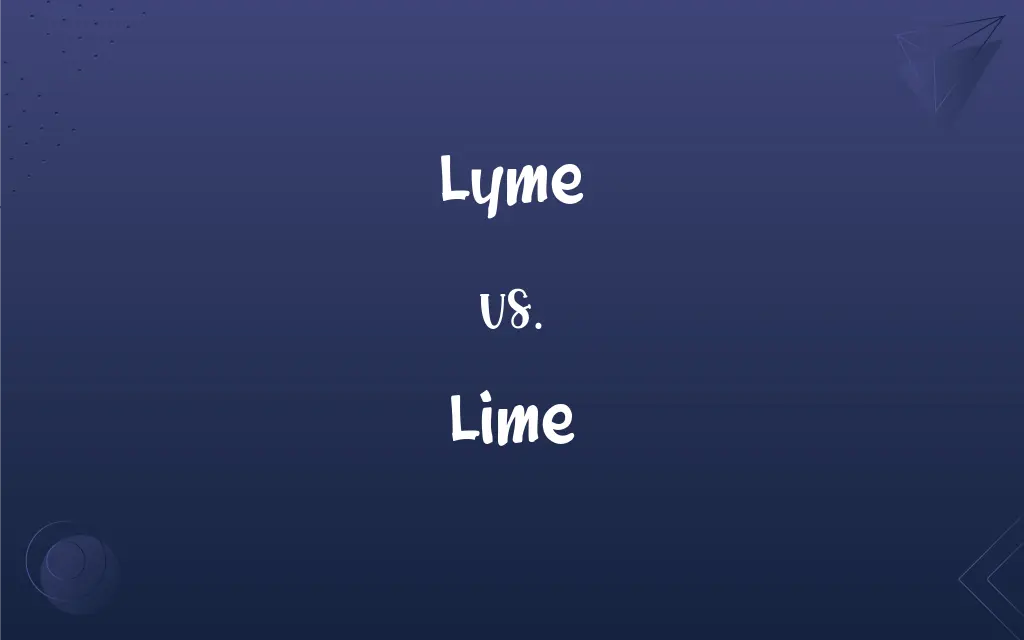Lyme vs. Lime: What's the Difference?
Edited by Harlon Moss || By Janet White || Updated on October 3, 2023
"Lyme" refers to Lyme disease, a tick-borne illness, while "Lime" is a green citrus fruit or a calcium-containing inorganic material.

Key Differences
"Lyme" and "Lime" are two distinct terms in the English language, each with its unique significance. "Lyme" is commonly associated with Lyme disease, an infectious ailment caused by the bacteria Borrelia burgdorferi, transmitted through the bite of infected black-legged ticks. Individuals with Lyme disease might experience symptoms like fever, fatigue, and skin rashes.
On the other hand, "Lime" brings to mind the tangy, green citrus fruit popular in many cuisines worldwide. It's a source of vitamin C and is used in beverages, cooking, and baking. Additionally, "Lime" can also refer to a white caustic alkaline substance consisting of calcium oxide, which is obtained by heating limestone and is used in making cement and mortar.
While "Lyme" predominantly denotes a medical condition, the term "Lime" boasts of a versatile application – from culinary to construction. It's essential to differentiate between the two, especially in contexts where clarity is paramount. For instance, mentioning "Lyme" in a culinary discussion or "Lime" in a medical one can lead to significant misunderstandings.
It's also worth noting that while "Lyme" is primarily associated with the illness, its origin is tied to the coastal town of Lyme, Connecticut, where the disease was first identified. Conversely, "Lime" as a fruit has been cultivated for thousands of years and has origins in Southeast Asia.
Comparison Chart
Primary Meaning
Refers to Lyme disease
A green citrus fruit or calcium-containing inorganic material
ADVERTISEMENT
Associated Field
Medicine
Culinary for fruit; Construction for the inorganic substance
Origin
Named after Lyme, Connecticut
Fruit's origin is Southeast Asia
Usage
Specific to the disease
Versatile, used in food, beverages, and construction
Related Terms
Borrelia burgdorferi, tick
Lemon, citrus, calcium oxide
Lyme and Lime Definitions
Lyme
Refers to the town of Lyme, Connecticut.
Lyme is a town located on the eastern coast of Connecticut.
ADVERTISEMENT
Lime
A green citrus fruit.
She added a squeeze of lime to her drink.
Lyme
A short form for Lyme disease.
He was diagnosed with Lyme after a camping trip.
Lime
A tree that bears lime fruits.
The lime tree in our backyard is full of fruits.
Lyme
A condition marked by skin rashes, fatigue, and fever.
Lyme symptoms can often be mistaken for the flu.
Lime
Any of several evergreen trees or shrubs of the genus Citrus having edible green or greenish-yellow fruit, especially the Mexican lime and the Persian lime.
Lyme
An infectious ailment treatable with antibiotics.
It's essential to get treatment for Lyme as soon as symptoms appear.
Lime
The fruit of any of these plants, having a pulpy interior and usually acid juice.
Lyme
A disease caused by bacteria transmitted by ticks.
Many people in wooded areas are concerned about contracting Lyme.
Lime
See linden.
Lyme
To hang out to spend time doing nothing in particular
Lime
See calcium oxide.
Lime
Any of various mineral and industrial forms of calcium oxide differing chiefly in water content and percentage of constituents such as magnesia, silica, alumina, and iron.
Lime
Birdlime.
Lime
To treat with lime.
Lime
To smear with birdlime.
Lime
To catch or snare with or as if with birdlime.
Lime
(chemistry) Any inorganic material containing calcium, usually calcium oxide (quicklime) or calcium hydroxide (slaked lime).
Lime
(poetic) Any gluey or adhesive substance; something which traps or captures someone; sometimes a synonym for birdlime.
Lime
(theatre) A spotlight.
Lime
A deciduous tree of the genus Tilia, especially Tilia × europaea; the linden tree.
Lime
The wood of this tree.
Lime
Any of several green citrus fruit, somewhat smaller and sharper-tasting than a lemon.
Lime
Any of the trees that bear limes, especially Key lime, Citrus aurantiifolia.
Lime
(uncountable) A brilliant, sometimes yellowish, green colour associated with the fruits of a lime tree.
Lime
(fandom) A fan fiction story which contains sexual references, but stops short of full, explicit descriptions of sexual activity (coined by analogy with lemon).
Lime
A casual gathering to socialize.
Lime
(transitive) To treat with calcium hydroxide or calcium oxide (lime).
Lime
(transitive) To smear with birdlime.
Lime
(rare) To ensnare, catch, entrap.
Lime
(transitive) To apply limewash.
Lime
To hang out/socialize in an informal, relaxed environment, especially with friends, for example at a party or on the beach.
Lime
Containing lime or lime juice.
Lime
Having the aroma or flavor of lime.
Lime
Lime-green.
Lime
A thong by which a dog is led; a leash.
Lime
The linden tree. See Linden.
Lime
The fruit of the Citrus aurantifolia, allied to the lemon, but greener in color; also, the tree which bears it.
Lime
The color of the lime{1}, a yellowish-green.
Lime
Birdlime.
Like the limeThat foolish birds are caught with.
Lime
Oxide of calcium, CaO; the white or gray, caustic substance, usually called quicklime, obtained by calcining limestone or shells, the heat driving off carbon dioxide and leaving lime. It develops great heat when treated with water, forming slaked lime, and is an essential ingredient of cement, plastering, mortar, etc.
Lime
To smear with a viscous substance, as birdlime.
These twigs, in time, will come to be limed.
Lime
To entangle; to insnare.
We had limed ourselvesWith open eyes, and we must take the chance.
Lime
To treat with lime, or oxide or hydrate of calcium; to manure with lime; as, to lime hides for removing the hair; to lime sails in order to whiten them; to lime the lawn to decrease acidity of the soil.
Land may be improved by draining, marling, and liming.
Lime
To cement.
Lime
Having a yellowish-green color like that of the lime (the fruit).
Lime
A caustic substance produced by heating limestone
Lime
A white crystalline oxide used in the production of calcium hydroxide
Lime
A sticky adhesive that is smeared on small branches to capture small birds
Lime
Any of various related trees bearing limes
Lime
Any of various deciduous trees of the genus Tilia with heart-shaped leaves and drooping cymose clusters of yellowish often fragrant flowers; several yield valuable timber
Lime
The green acidic fruit of any of various lime trees
Lime
Spread birdlime on branches to catch birds
Lime
Cover with lime so as to induce growth;
Lime the lawn
Lime
Calcium oxide or calcium hydroxide.
Lime is used in making cement and mortar.
Lime
A sharp-tasting acidic fruit.
The dish needs a touch of lime for extra flavor.
Lime
A substance used to improve soil quality.
Farmers spread lime on fields to reduce soil acidity.
FAQs
What causes Lyme?
The bacteria Borrelia burgdorferi transmitted by ticks.
Is "Lyme" always related to the disease?
Primarily, yes, but it's also the name of a town in Connecticut.
Can "Lime" be both a fruit and a substance?
Yes, it refers to a citrus fruit and a calcium-containing material.
Is "Lyme" contagious between people?
No, Lyme disease is transmitted through ticks.
Are there vaccines for Lyme?
As of now, there's no human vaccine for Lyme disease.
Are there different types of lime fruit?
Yes, such as Key lime and Persian lime.
Is "Lime" the same as "Lemon"?
No, they are different citrus fruits.
Can Lyme be cured?
Yes, especially when treated early with antibiotics.
Is Lyme prevalent worldwide?
It's most common in North America and parts of Europe and Asia.
Can you eat lime in its entirety?
Generally, the juice and zest are consumed; the peel is often discarded.
What's the difference between lime and limestone?
Lime is derived from heating limestone.
How can you prevent Lyme?
Avoid tick-infested areas and use repellents.
How long does lime last?
Lime fruit lasts about a week at room temperature.
How is Lyme diagnosed?
Through clinical signs and lab tests.
Can lime be used in desserts?
Yes, like in key lime pie.
What does lime taste like?
It's tart with a slightly sweet undertone.
Is chronic Lyme disease real?
It's controversial, but some patients report persistent symptoms.
Is lime juice acidic?
Yes, it's commonly used to add acidity to dishes.
Are Lyme symptoms immediate?
Symptoms usually appear 3 to 30 days after a tick bite.
Is lime good for health?
Yes, it's rich in vitamin C and other nutrients.
About Author
Written by
Janet WhiteJanet White has been an esteemed writer and blogger for Difference Wiki. Holding a Master's degree in Science and Medical Journalism from the prestigious Boston University, she has consistently demonstrated her expertise and passion for her field. When she's not immersed in her work, Janet relishes her time exercising, delving into a good book, and cherishing moments with friends and family.
Edited by
Harlon MossHarlon is a seasoned quality moderator and accomplished content writer for Difference Wiki. An alumnus of the prestigious University of California, he earned his degree in Computer Science. Leveraging his academic background, Harlon brings a meticulous and informed perspective to his work, ensuring content accuracy and excellence.































































